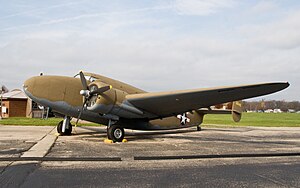Lockheed Model 18 Lodestar
| Model 18 Lodestar C-56 / C-57 / C-60 / R5O |
|
|---|---|
 |
|
| Role | Passenger transport |
| National origin | United States |
| Manufacturer | Lockheed |
| First flight | September 21, 1939 |
| Introduction | March 30, 1940 |
| Primary user | United States Army Air Corps |
| Number built | 625 |
| Developed from | Lockheed Model 14 Super Electra |
| Variants | Lockheed Ventura |
The Lockheed Model 18 Lodestar is a passenger transport aircraft of the World War II era.
Sales of the 10–14 passenger Lockheed Model 14 Super Electra, which first flew in 1937, had proved disappointing, despite the aircraft's excellent performance, as it was more expensive to operate than the larger Douglas DC-3, already in widespread use. In order to improve the type's economics, Lockheed decided to stretch the aircraft's fuselage by 5 feet 6 inches (1.68 m), allowing an extra two rows of seats to be fitted.
The prototype for the revised airliner, designated Model 18 by Lockheed, was converted from the fourth Model 14, one of a batch which had been returned to the manufacturer by Northwest Airlines after a series of crashes. The modified aircraft first flew in this form on September 21, 1939, another two prototypes being converted from Model 14s, with the first newly built Model 18 flying on February 2, 1940.
A total of 625 Lodestars of all variants were built.
The Lodestar received its Type certificate on March 30, 1940, allowing it to enter service with the first customer, Mid-Continent Airlines that month. As hoped, the extra seats greatly improved the Model 18's economics, reducing its seat-mile costs to a similar level to that of the DC-3, while retaining superior performance. Despite this, sales to US domestic customers were relatively slow as most US airlines were already committed to the DC-3, with only 31 Lodestars going to US airlines. Overseas sales were a little better, with 29 bought by the government of the Netherlands East Indies. South African Airways (21), New Zealand National Airways Corporation (13), Trans-Canada Air Lines (12) and BOAC (9) who were the biggest airline customers. Various Pratt & Whitney and Wright Cyclone powerplants were installed.
...
Wikipedia
